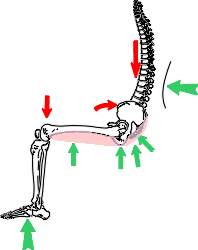Comfort
Most projects start with a definition of the occupants, for example using ticket sales data to find the proportion of different nationalities and the sex mix. This definition is used in PeopleSize to create an anthropometry database, from which the percentage of customers who will fit any particular seat dimension is determined. We also determine the proportion of occupants who will fit in every important dimension at once (some seats, when analysed like this, turn out not to fit anyone at all!).
Then we consider the opportunities in the specific situation for optimising the shape, adjustments, foam, and geometry of the seat. This stage takes into account the manufacturing technology, the space available, cost, weight and maintenance.
Testing can then include comfort trials, sleep trials, and pressure-mapping, and comparative testing can prove and quantify the advantage over the previous or competing seats..
Some Physiological Issues
The illustration below shows some of the factors that we deal with in seat design. The red arrows show the main gravitational forces on the body, and the green arrows show how the seat has to deliver its support.
 | The seat has to:
|
To achieve this, the seat has to have an ergonomics specification, which includes dimensions, shape, geometry, adjustment ranges and cushioning. Other factors can include head and shoulder posture, armrests, footrest, and movements associated with seated tasks. Projects sometimes start with concept design using CAD modelling, to find the best postures within a given space. Sometimes the project is an Audit of an existing or prototype seat, looking for ways to make quick improvements. http://www.openerg.com/seating.htm |
No comments:
Post a Comment